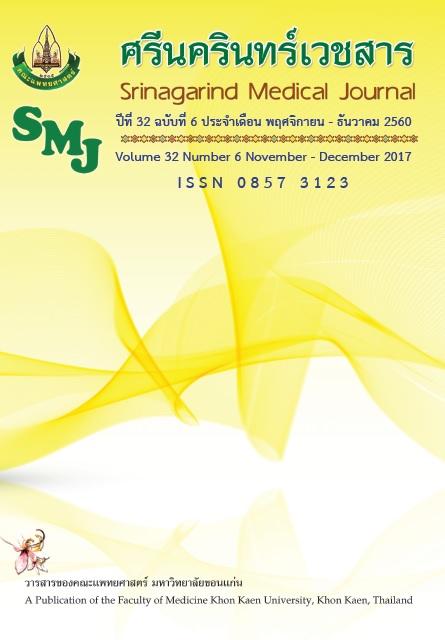Cancer Associated Fibroblasts (CAFs): a New Subtype or a Different Cell State?
Keywords:
FibroblastsAbstract
Stroma is a supportive framework of tissue, which consists of mixed connective tissue cells (such as fibroblast, immune cell, andendothelial cell) and also an extracellular matrix. A remodeling of the stroma is a physiological process that occurs during wound healing. In many cancers, the stromal remodeling is continuously occurring in response to chronic inflammation. As a result, the desmoplastic reaction or growth of fibrous tissue that similar to “a wound that does not heal” is one hallmark of several solid cancers. The fibroblast in cancer microenvironment exhibits the different characteristics from the normal one; therefore, it is called “cancer-associated fibroblast (CAF)”. There are three proposed origins of CAF; 1) resident fibroblast, 2) bone marrow derived mesenchymal stem cell or 3) cancer cell through the epithelial to mesenchymal transition. Many recent studies indicate that CAF promotes cancer cell properties such as cell proliferation, anti-apoptosis, migration/invasion, metastasis, and drug resistance through the secreted factors. Experimentally in vitro and in the animal model, the characteristics of CAF and normal fibroblast seem to be interchangeable and this would induce cell death, inhibit tumor growth, suppress metastasis and alleviate drug resistance. This might provide the therapeutic opportunities for the adjunct CAF modification and cancer cell eradication that might offer the superior the therapeutic outcome for cancer patients.
สโตรมาหรือโครงร่างค้ำจุนเนื้อเยื่อ ประกอบด้วยเซลล์ของเนื้อเยื่อเกี่ยวพัน เช่น ไฟโบรบลาสท์ เซลล์ภูมิคุ้มกัน เซลล์เยื่อบุหลอดเลือด และเมทริกซ์ภายนอกเซลล์ ทำหน้าที่รักษารูปร่างของเนื้อเยื่อ โดยสโตรมาจะเกิดการปรับเปลี่ยนรูปร่าง เมื่อเกิดการบาดเจ็บของเนื้อเยื่อเพื่อซ่อมแซมบาดแผล ซึ่งกระบวนการนี้ จะเกิดขึ้นอย่างต่อเนื่องตอบสนองต่อการอักเสบเรื้อรังในเนื้อเยื่อมะเร็งทำให้เกิดการเจริญผิดปกติของพังผืด “คล้ายแผลที่ไม่มีวันหาย” ซึ่งคุณลักษณะนี้เรียกว่า desmoplastic reaction เป็นลักษณะเด่นของมะเร็งหลายชนิด จากการศึกษาพบว่าไฟโบรบลาสท์ในเนื้อเยื่อมะเร็งแตกต่างจากไฟโบรบลาสท์ปกติ จึงเรียกว่า cancer-associated fibroblast (CAF) เชื่อว่า CAF มีต้นกำเนิดจาก 3 แหล่ง ได้แก่ 1) จากไฟโบรบลาสท์ในอวัยวะ 2) เซลล์ต้นกำเนิดในไขกระดูก หรือ 3) เปลี่ยนแปลงมาจากเซลล์มะเร็ง พบว่า CAF ทำหน้าที่ส่งเสริมเซลล์มะเร็ง เช่น กระตุ้นการเพิ่มจำนวน ยับยั้งการตาย ส่งเสริมการแพร่กระจาย รวมทั้งทำให้ดื้อยาต้านของเซลล์มะเร็งผ่านสารคัดหลั่งต่าง ๆการศึกษาทางห้องปฏิบัติการและในสัตว์ทดลองพบว่า เมื่อเหนี่ยวนำให้ CAF เปลี่ยนกลับเป็นไฟโบรบลาสท์ปกติจะเหนี่ยวนำให้เซลล์มะเร็งตาย ชะลอการเจริญเติบโตของมะเร็ง ยับยั้งการแพร่กระจายและลดการดื้อยาของมะเร็งได้ ดังนั้นการรักษาที่เน้นกำจัดเซลล์มะเร็งร่วมกับการรักษาเซลล์แวดล้อมของมะเร็ง จึงเป็นแนวทางการรักษาแบบใหม่ที่น่าจะช่วยเพิ่มประสิทธิภาพได้




